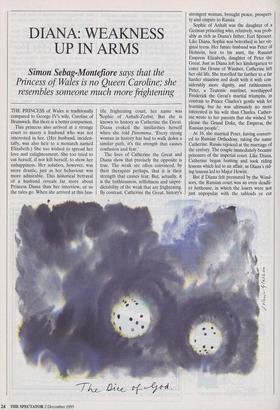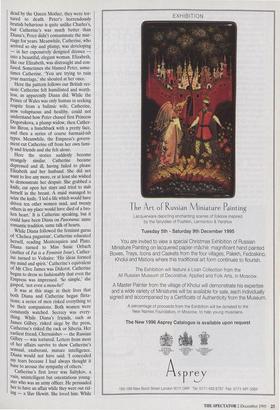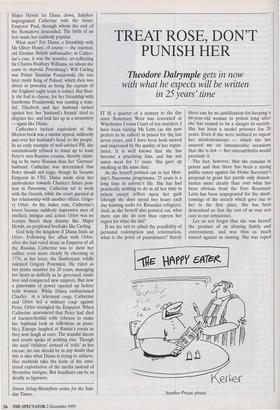DIANA: WEAKNESS UP IN ARMS
Simon Sebag-Montefiore says that the
Princess of Wales is no Queen Caroline; she resembles someone much more frightening
THE PRINCESS of Wales is traditionally compared to George IV's wife, Caroline of Brunswick. But there is a better comparison.
This princess also arrived at a strange court to marry a husband who was not interested in her. (Her husband, inciden- tally, was also heir to a monarch named Elizabeth.) She too wished to spread her love and enlightenment. She too tried to cut herself, if not kill herself, to show her unhappiness. Her solution, however, was more drastic, just as her behaviour was more admirable. This historical betrayal of a husband reveals far more about Princess Diana than her interview, or so the tales go. When she arrived at this hos- tile frightening court, her name was 'Sophie of Anhalt-Zerbst. But she is known to history as Catherine the Great. Diana evoked the similarities herself when she told Panorama, 'Every strong woman in history has had to walk doWn a similar path, it's the strength that causes confusion and fear.'
The lives of Catherine the Great and Diana show that precisely the opposite is true. The weak are often convinced, by their therapists perhaps, that it is their strength that causes fear. But, actually, it is the faithlessness, selfishness and unpre- dictability of the weak that are frightening. By contrast, Catherine the Great, history's strongest woman, brought peace, prosperi- ty and empire to Russia.
Sophie of Anhalt was the daughter of a German princeling who, relatively, was prob- ably as rich as Diana's father, Earl Spencer. Like Diana, Sophie was betrothed in her vir- ginal teens. Her future husband was Peter of Holstein, heir to his aunt, the Russian Empress Elizabeth, daughter of Peter the Great. Just as Diana left her kindergarten to enter the House of Windsor, Catherine left her old life. She travelled far further to a far harder situation and dealt with it with con- siderably more dignity, and ruthlessness. Peter, a Teutonic martinet, worshipped Frederick the Great's martial triumphs, in contrast to Prince Charles's gentle wish for learning, but he was ultimately no more interested in his wife than Charles. Cather- ine wrote to her parents that she wished 'to please the Grand Duke, the Empress, the Russian people'.
At 16, she married Peter, having convert- ed to Russian Orthodoxy, taking the name Catherine. Russia rejoiced at the marriage of the century. The couple immediately became prisoners of the imperial court. Like Diana, Catherine began hunting and took riding lessons which led to an affair, as Diana's rid- ing lessons led to Major Hewitt.
But if Diana felt pressured by the Wind- sors, the Russian court was an even deadli- er hothouse, in which the losers were not just unpopular with the tabloids or cut dead by the Queen Mother, they were tor- tured to death. Peter's horrendously brutish behaviour is quite unlike Charles's, but Catherine's was much better than Diana's. Peter didn't consummate the mar- riage for years. Meanwhile, Catherine, who arrived so shy and plump, was developing — in her expensively designed dresses into a beautiful, elegant woman. Elizabeth, like our Elizabeth, was distraught and con- fused. Sometimes she blamed Peter, some- times Catherine. 'You are trying to ruin your marriage,' she shouted at her once.
Here the pattern follows our British ver- sion: Catherine felt humiliated and worth- less, as apparently Diana did. While the Prince of Wales was only human in seeking respite from a bulimic wife, Catherine, now voluptuous and healthy, could not understand how Peter chased first Princess Dogorukova, a plump widow, then Cather- ine Biron, a hunchback with a pretty face, and then a series of coarse barmaid-ish types. Meanwhile, the Empress's govern- ment cut Catherine off from her own fami- ly and friends and she felt alone.
Here the stories suddenly become strangely similar. Catherine became depressed and ill, having failed to please Elizabeth and her husband. She did not want to live any more, or at least she wished t❑ demonstrate her despair. She grabbed a knife, cut open her stays and tried to stab herself in the breast. A maid managed to seize the knife. led a life which would have driven ten other women mad, and twenty others in my place would have died of a bro- ken heart.' It is Catherine speaking, but it could have been Diana on Panorama: same romantic tradition, same talk of hearts.
While Diana followed the feminist gurus of 'Chelsea paganism', Catherine educated herself, reading Montesquieu and Plato. Diana turned to Miss Susie Orbach (author of Fat is a Feminist Issue). Cather- ine turned to Voltaire: 'His ideas formed my mind and spirit.' Catherine's equivalent of Mr Clive James was Diderot. Catherine began to dress so fashionably that even the Empress was impressed. 'So simple,' she gasped, 'not even a mouche!'
It was at this stage in their lives that both Diana and Catherine began flirta- tions; a series of men risked everything to be their companions. Both women were constantly watched. Secrecy was every- thing. While Diana's friends, such as James Gilbey, risked siege by the press, Catherine's risked the rack or Siberia. Her earliest friend, Chernuishev — the Russian Gilbey —. was tortured. Letters from most of her affairs survive to show Catherine's sensual, exuberant, mature intelligence. Diana would not have said: 'I concealed my tears because I had always thought it base to arouse the sympathy of others.' Catherine's first lover was Saltykov, a vain, unintelligent but ostentatious young- ster who was an army officer. He persuaded her to have an affair while they were out rid- ing — a Slav Hewitt. She loved him. While Major Hewitt let Diana down, Saltykov impregnated Catherine with the future Emperor Paul, through whom the rest of the Rornanovs descended. The birth of an heir made her suddenly popular.
What next? For Diana, a friendship with Mr Oliver Hoare, of course — the married, old Etonian British ambassador; in Cather- ine's case, it was the sensitive art-collecting Sir Charles Hanbury Williams, on whom she came to depend. Petersburg's Will Carling was Prince Stanislas Poniatowski (he was later made King of Poland, which then was about as powerful as being the captain of the England rugby team is today). But final- ly she had to choose, for her friendship with handsome Poniatowski was causing a scan- dal. Elizabeth and her husband turned against her; her 'husband's friends' tried to disgrace her, and lock her up in a monastery — again like Diana.
Catherine's tactical equivalent of the Morton book was a similar appeal, indirectly and over her husband's head, to the people. In an early example of well-advised PR, she ostentatiously refused to stand up to toast Peter's non-Russian cousins, thereby claim- ing to be more Russian- than her `German' husband. Catherine was determined that Peter should not reign, though he became Emperor in 1761. Diana made clear her ambivalence towards Charles's future posi- tion in Panorama. Catherine set to work with the Guards, while the court guessed at her relationship with another officer, Grigo- ry Orlov. As the stakes rose, Catherine's lovers became suddenly impressive men of intellect, intrigue and action: Orlov was no Jermyn Street shop dummy like Major Hewitt, no perplexed beefcake like Carling.
God help the kingdom if Diana finds an Orlov. Following her affair with Orlov, after she had ruled alone as Empress of all the Russias, Catherine was to show her calibre even more clearly by choosing in 1774, as her lover, the flamboyant, wildly talented Grigory Potemkin. He ruled as her prime minister for 20 years, managing her heart as skilfully as he governed, made love and conquered new empires. But now a panorama of power opened up before both women. While Diana embarrassed Charles in a televisual coup, Catherine and Orlov led a military coup against Peter. Orlov strangled the Emperor. When Catherine announced that Peter had died of haemorrhoidal colic (chosen to make her husband look as ridiculous as possi- ble), Europe laughed at Russia's royals as they now laugh at ours. The scandal sheets and courts spoke of nothing else. Though she used `children' instead of `colic' as her excuse, no one should be in any doubt that this is also what Diana is trying to achieve. Her methods take the form of the emo- tional exploitation of the media instead of Byzantine intrigue. But headlines can be as deadly as ligatures.
Simon Sebag-Montefiore writes for the Sun- day Times.












































































 Previous page
Previous page